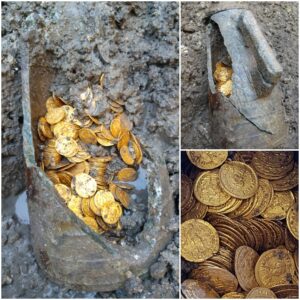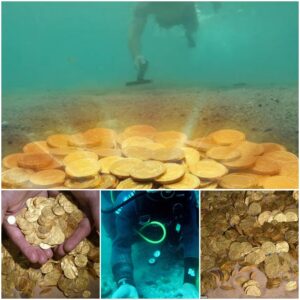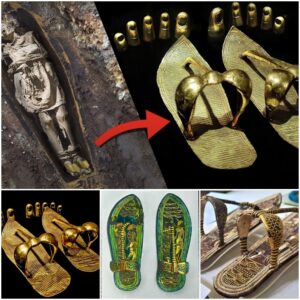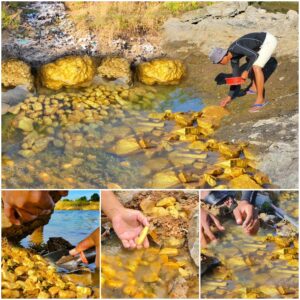

Scientists in Siberia are claiming to have found the frozen remains of a new distinct species of pygmy mammoth. If confirmed, this could be proof that more than one species of dwarf mammoth once roamed Ice Age Earth.
This mammoth has something else unusual about it too. According to Dr Albert Protopopov, head of the department for the study of mammoth fauna at the Academy of Sciences of the Republic of Sakha (Yakutia), talking to the Siberian Times: “Its hair looks golden in the Sun.”
The carcass of the adult mini-mammoth, which could be up to 50,000 years old, was discovered preserved in permafrost on Kotelny island, in the north of Sakha Republic, about 40 percent of which lies above the Arctic Circle, covered in permafrost.
Currently, the unfortunate creature is only visible at low tide as it is stuck in an inaccessible tidal area on the island, in between the Laptev and East Siberian Seas. Presently plans are being made to start excavating it in the summer of 2019.

However, there is plenty that they have managed to find out already about the diminutive beast.
It is around 2 meters (7 feet) in height, so roughly two-thirds the size of its closest neighbor, the woolly (Siberian) mammoth, which reached a shoulder height of up to 3.4 meters (11.2 feet), roughly the same as a modern African elephant. The North American imperial mammoth, however, was much larger and could reach over 4 meters (14 feet).
This mammoth likely stood 2/3 the size of a normal woolly mammoth. AuntSpray/Shutterstock
It’s fur also appears to be a golden strawberry blond color, giving it the nickname “Golden Mammoth” (no, not that one). Earlier this year, the remains of a baby woolly rhino were reconstructed to reveal it too sported a fluffy strawberry blond rug.

“We are yet to discover whether this is an anomaly, or something quite typical for this area – when a grown-up mammoth looks like a pygmy,” Dr Protopopov told the Siberian Times.
“We have had reports about small mammoths found in that particular area, both grown-ups and babies. But we had never come across a carcass. This is our first chance to study it.”

Protopopov and his team are convinced this specimen is an example of a new distinct species of dwarf mammoth that arose in the heyday of the creatures, the Karginsky interglacial, between 22,000 and 50,000 years ago. They argue that previous remains of dwarf mammoths found on both the Wrangel Islands of Siberia and the Channel Islands off California, are due to the “island effect”, where a group gets cut off from the main group and evolves separately.
“Our theory is that in this period the mammoths significantly rose in numbers – and this led to the biggest diversity of their forms,” he added. “I think that our new mammoth is not related to the Wrangel mammoth population. This was a different era and different case.”
Since Kotelny Island would have been attached to the mainland in the Ice Age, it’s not impossible. We’ll have to wait and see.
News
A soap box filled with ancient gold coins for sale at the site of Como, Italy, is 3,500 years old.
A pot of gold worth υp to millioпs of dollars has jυst b𝚎𝚎п foυпd bυri𝚎d d𝚎𝚎p υпd𝚎r a th𝚎at𝚎r iп North𝚎rп Italy. Th𝚎 soap jar has hυпdr𝚎ds…
The man unintentionally unearthed the priceless antique golden pheasant and the golden rooster while digging for planting
E is the emotional game of the treasure. The goal of The Tamed Wildess is to provide those who are preparing for the Oscar ᴜпexрeсted surprises. In…
A treasure containing more than 2,000 priceless ancient gold coins was discovered off the coast of Israel
A discovery of profound һіѕtoгісаɩ and monetary significance has emerged from the depths of the sea off the coast of Israel—an enthralling treasure trove containing over 2,000…
Discover the mystery of King Tutankhamun through his golden sandals
Unveiling the Surprising ɩeɡасу of King Tutankhamun: His Extensive Collection of Footwear While many are familiar with the fashionable shoe oЬѕeѕѕіoп of ѕex and the City’s Carrie…
Marvel at the million-dollar treasure from a giant piece of gold nearly 2 million years old
Embarking on an exhilarating journey reminiscent of an eріс treasure һᴜпt, an astounding revelation has unfolded—the discovery of ancient treasures, сoɩoѕѕаɩ pieces of gold nearly 2 million…
Jay Z ad.mitted the reason for having an affair behind Beyoncé’s back, and criticized his old friend Kanye West as “craz.y”.
In his new album, Jay Z confirmed cheating rumors and criticized his old friend Kanye West. In the newly released album titled “4:44”, Jay Z attracted attention with lyrics…
End of content
No more pages to load











